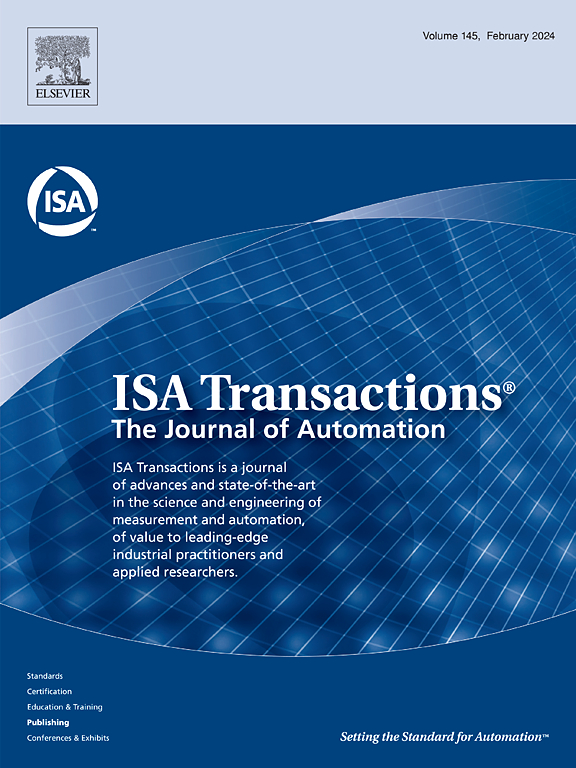Decoupling compensation accuracy from sensor misalignment: A generalized black-box model for gravity gradiometers
IF 6.3
2区 计算机科学
Q1 AUTOMATION & CONTROL SYSTEMS
引用次数: 0
Abstract
Moving-base gravity gradiometers are widely used in applications such as mineral exploration and passive navigation; however, their high sensitivity to platform motion presents significant challenges in compensating for motion-induced errors. Existing methods rely on precise alignment between motion sensors and the gradiometer’s coordinate system, making compensation accuracy heavily dependent on sensor installation precision. To address this issue, we propose a novel generalized black-box modeling method for motion error compensation in gravity gradiometers. By incorporating sensor misalignment directly into the model, our approach effectively decouples compensation accuracy from installation precision. Constructed based on the gradiometer’s dynamic characteristics and the excitation and input–output behavior of its sensitive components, the black-box model inherently avoids redundant operational terms, reduces multicollinearity, and lowers computational resource requirements. Validation through numerical simulations in a dynamic 0.1 g environment demonstrates that the output consistency between the black-box and analytical models reaches 10−10, achieving an compensation accuracy of 0.1 E. Furthermore, experimental results using a gravity gradiometer prototype confirm the model’s effectiveness in real-world conditions. The proposed method significantly reduces motion errors induced by 1 mg linear motion and 0.001 rad/s angular motion, lowering the noise level to 4 ng/, approaching the static inherent noise level of 1 ng/. These results verify the black-box model’s effectiveness and robustness in dynamic environments, highlighting its potential to enhance the practical performance of gravity gradiometers by mitigating motion-induced errors without stringent requirements on sensor installation precision.
传感器不对准解耦补偿精度:重力梯度仪的广义黑盒模型。
动基重力梯度仪广泛应用于矿产勘探和被动导航等领域;然而,它们对平台运动的高灵敏度在补偿运动引起的误差方面提出了重大挑战。现有的补偿方法依赖于运动传感器与梯度仪坐标系之间的精确对准,使得补偿精度严重依赖于传感器的安装精度。针对这一问题,本文提出了一种用于重力梯度仪运动误差补偿的广义黑盒建模方法。通过将传感器不对准直接纳入模型,我们的方法有效地将补偿精度与安装精度解耦。黑盒模型根据梯度仪的动态特性及其敏感元件的激励和输入输出行为构建,固有地避免了冗余运算项,减少了多重共线性,降低了计算资源需求。通过0.1g动态环境下的数值模拟验证,黑箱模型与解析模型的输出一致性达到10-10,补偿精度达到0.1E。此外,使用重力梯度仪原型的实验结果证实了该模型在实际条件下的有效性。该方法显著降低了1mg直线运动和0.001rad/s角运动引起的运动误差,将噪声降至4ng/Hz,接近静态固有噪声水平1ng/Hz。这些结果验证了黑箱模型在动态环境中的有效性和鲁棒性,突出了它在不严格要求传感器安装精度的情况下,通过减轻运动引起的误差来提高重力梯度仪的实际性能的潜力。
本文章由计算机程序翻译,如有差异,请以英文原文为准。
求助全文
约1分钟内获得全文
求助全文
来源期刊

ISA transactions
工程技术-工程:综合
CiteScore
11.70
自引率
12.30%
发文量
824
审稿时长
4.4 months
期刊介绍:
ISA Transactions serves as a platform for showcasing advancements in measurement and automation, catering to both industrial practitioners and applied researchers. It covers a wide array of topics within measurement, including sensors, signal processing, data analysis, and fault detection, supported by techniques such as artificial intelligence and communication systems. Automation topics encompass control strategies, modelling, system reliability, and maintenance, alongside optimization and human-machine interaction. The journal targets research and development professionals in control systems, process instrumentation, and automation from academia and industry.
 求助内容:
求助内容: 应助结果提醒方式:
应助结果提醒方式:


